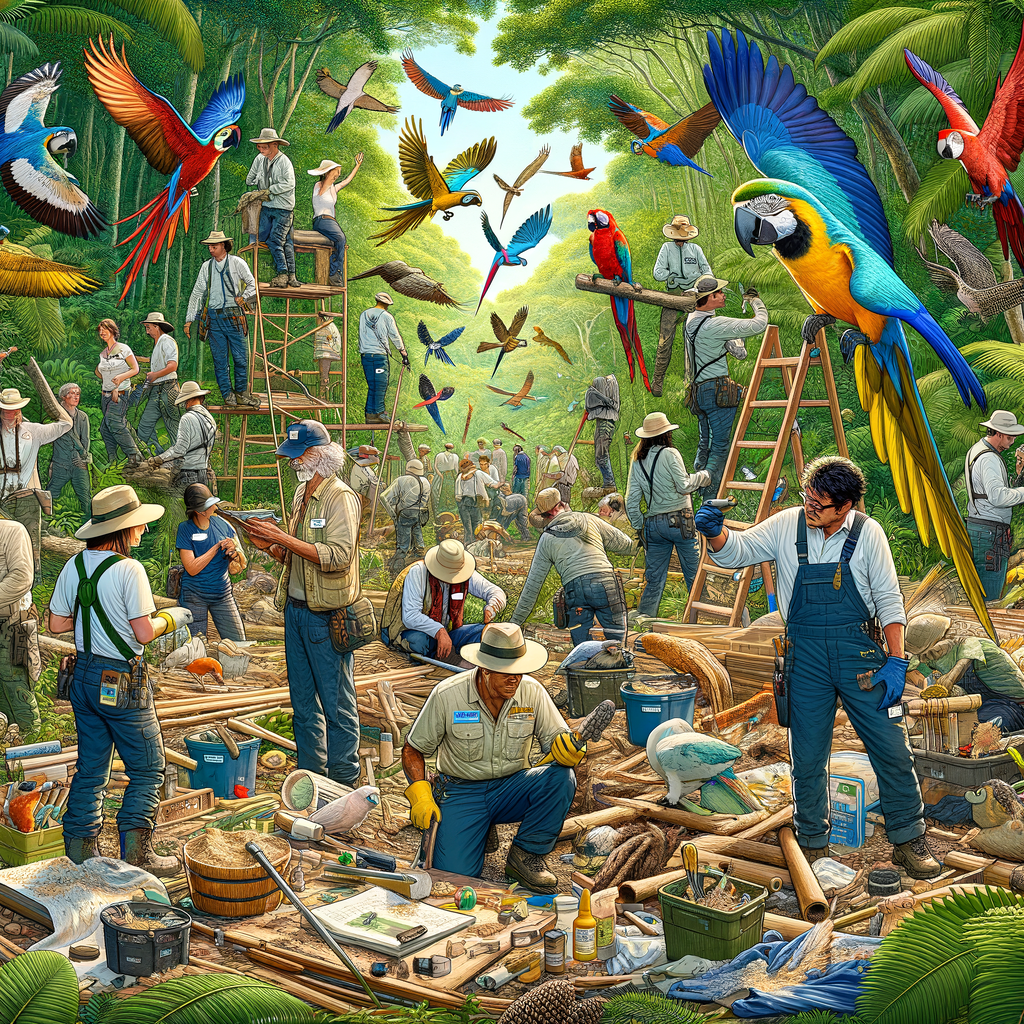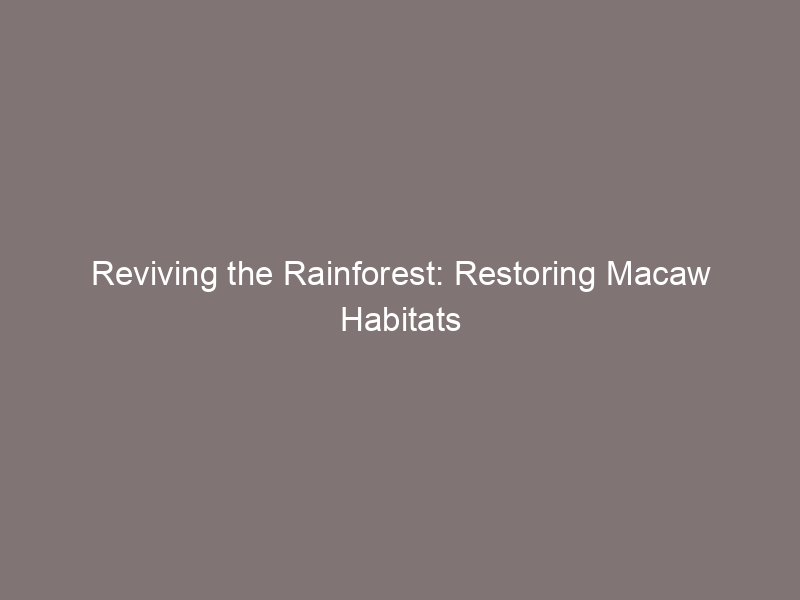
Introduction to Macaw Habitat
Macaws are vibrant, large-sized parrots that are known for their impressive lifespan and striking colors. They are native to Central and South America, and their natural habitat plays a crucial role in their survival and well-being. In this section, we will delve into the natural environment of Macaws and understand why the rainforest is so important for these species.
- Understanding the natural environment of Macaws
- Importance of the rainforest for Macaw species
Macaws are tropical birds and they thrive in rainforests, savannas, and even high-altitude cloud forests. These environments provide them with plenty of food sources, such as fruits, nuts, and seeds. The lush, dense vegetation of the rainforest also provides ample opportunities for nesting and protection from predators. Macaws are highly social birds and often live in large flocks. They are also known for their loud calls and squawks, which can be heard for miles in the dense forest.
The rainforest is a vital habitat for Macaws. It provides them with everything they need to survive – food, shelter, and a place to breed. The vast biodiversity of the rainforest ensures a steady supply of food throughout the year. Furthermore, the tall trees of the rainforest offer safe nesting spots away from ground predators. Unfortunately, the destruction of these rainforests due to deforestation and urbanization is a major threat to the survival of Macaws. Protecting and preserving these habitats is crucial for the continued existence of these beautiful birds.
In the following sections, we will explore the current state of Macaw habitats, the efforts being made to restore them, and what the future holds for these magnificent creatures.
Current State of Macaw Habitats
The vibrant and colorful macaws, known for their long tails and large size, are native to the tropical regions of Central and South America. These birds are highly adaptable and can thrive in a variety of habitats, including rainforests, savannas, and even high-altitude cloud forests. However, the current state of macaw habitats is a cause for concern.
Threats to Macaw Habitats
Two significant threats are currently impacting the habitats of these beautiful birds: deforestation and climate change.
- Deforestation and its impact on Macaw habitats
- Climate change and its effect on tropical bird habitats
Deforestation is the process of clearing large areas of forests, often to make way for agricultural activities or urban development. This practice is particularly prevalent in the Amazon rainforest, a primary habitat for many macaw species. According to the World Wildlife Fund, an estimated 20% of the Amazon has been lost in the last 50 years due to deforestation. This loss of habitat has led to a significant decrease in macaw populations.
Climate change is another significant threat to macaw habitats. Rising temperatures, altered rainfall patterns, and increased frequency of extreme weather events can drastically affect the ecosystems where macaws live. For instance, changes in temperature and rainfall can affect the growth of plants that macaws rely on for food. Additionally, extreme weather events like hurricanes can destroy nests and displace macaw populations.
In conclusion, the current state of macaw habitats is precarious, with deforestation and climate change posing significant threats. However, through conservation efforts and habitat restoration, there is hope for the future of these magnificent birds.
Habitat Restoration: A Hope for Macaws
Macaws, known for their vibrant colors and loud voices, are a symbol of the rainforest. However, their habitats are under threat due to deforestation and other human activities. But there is hope. Through habitat restoration, we can provide a brighter future for these magnificent birds.
Rebuilding Bird Habitats: Strategies and Techniques
There are several ways we can help restore the habitats of Macaws. Let’s explore some of the most effective strategies and techniques.
- Reforestation: Planting trees to restore the rainforest
- Creating artificial nests to support Macaw breeding
One of the most effective ways to restore the Macaw’s habitat is through reforestation. This involves planting native trees to recreate the lush, dense rainforests that Macaws call home. Reforestation not only provides a home for Macaws but also helps combat climate change by absorbing carbon dioxide from the atmosphere.
Another strategy is creating artificial nests. Macaws have specific nesting requirements, and the loss of suitable trees can impact their breeding success. By installing artificial nests in areas with a lack of suitable natural nesting sites, we can provide safe and secure places for Macaws to raise their young.
These are just a few of the ways we can help restore Macaw habitats. By implementing these strategies, we can ensure a brighter future for these beautiful and important creatures.
Case Studies in Macaw Conservation
In the next section, we will look at some successful case studies in Macaw conservation. These stories will provide real-world examples of how these strategies and techniques have been put into action, and the positive impact they have had on Macaw populations.
Case Studies in Macaw Conservation
Let’s take a closer look at some successful efforts in Macaw conservation. These case studies highlight the power of dedicated teams and well-planned projects in restoring Macaw habitats and populations.
Successful Wildlife Restoration Projects
There are several wildlife restoration projects that have made significant strides in Macaw conservation. We will focus on two such projects: Project Ara and The Tambopata Macaw Project.
-
Project Ara: A case study in Macaw habitat restoration
Project Ara is a shining example of successful Macaw habitat restoration. Located in Costa Rica, this project focuses on the Great Green Macaw, a species that was on the brink of extinction due to habitat loss.
Project Ara’s efforts have been centered on reforestation, creating a safe and thriving environment for the Macaws. They have planted over 5,000 trees, providing the birds with the necessary food and shelter. The project also includes a breeding program, which has successfully released over 100 Macaws into the wild.
The success of Project Ara shows that with dedication and hard work, it is possible to restore Macaw habitats and populations.
-
The Tambopata Macaw Project: A model for bird conservation projects
The Tambopata Macaw Project in Peru is another success story in Macaw conservation. This project has focused on research, habitat protection, and community involvement to protect and restore Macaw populations.
Through their research, the Tambopata Macaw Project has gained valuable insights into Macaw behavior, diet, and breeding habits. This knowledge has been instrumental in their conservation efforts. The project has also worked closely with local communities, educating them about the importance of Macaw conservation and involving them in the project.
The Tambopata Macaw Project serves as a model for other bird conservation projects, demonstrating the importance of research, habitat protection, and community involvement in successful conservation efforts.
These case studies highlight the potential for successful Macaw conservation. With the right strategies and dedication, we can ensure a brighter future for these beautiful birds.
Future of Macaw Habitats
The future of Macaw habitats is a topic of great concern and importance. With the increasing threats to their natural habitats, it is crucial to take proactive steps to ensure their survival. The role of communities in wildlife restoration is pivotal in this regard. Let’s delve into how community involvement and education can make a significant difference.
Role of Communities in Wildlife Restoration
Communities play a vital role in wildlife restoration. Their involvement can bring about a significant change in the state of Macaw habitats. Let’s explore this further.
- Community involvement in habitat restoration efforts
- Education and awareness: Key to sustainable Macaw conservation
Local communities can contribute immensely to habitat restoration efforts. They can participate in tree planting initiatives, clean-up drives, and habitat monitoring activities. Their involvement ensures that the restoration efforts are sustained over time. For instance, in the Amazon region, local communities have been instrumental in reforesting areas that were once destroyed due to deforestation.
Education and awareness are the keys to sustainable Macaw conservation. By educating communities about the importance of Macaws and their role in the ecosystem, we can inspire them to take action. Schools can incorporate wildlife conservation in their curriculum, and local authorities can organize awareness campaigns. This education can lead to a better understanding of the importance of these birds and the need to protect their habitats.
In conclusion, the future of Macaw habitats depends largely on the actions we take today. Community involvement and education are two powerful tools that can help us ensure a brighter future for these magnificent birds.
Conclusion: A Brighter Future for Macaws
In conclusion, the future of Macaws is becoming brighter day by day due to the relentless efforts of conservationists and environmentalists. Two key factors are playing a significant role in this positive change: the importance of continued efforts in habitat restoration and how restoring Macaw habitats contributes to a healthier ecosystem.
- Importance of Continued Efforts in Habitat Restoration
- How Restoring Macaw Habitats Contributes to a Healthier Ecosystem
The continuous efforts in restoring the natural habitats of Macaws are crucial. These efforts not only provide a safe and natural environment for Macaws to thrive but also help in maintaining the biodiversity of our planet. Habitat restoration projects have shown promising results. For instance, the number of Scarlet Macaws in Costa Rica has increased from a few hundred in the 1990s to over 1500 today, thanks to the restoration of their natural habitats.
Restoring the habitats of Macaws has a ripple effect on the overall health of our ecosystem. Macaws play a vital role in seed dispersal, which aids in the growth of tropical forests. These forests, in turn, act as carbon sinks, absorbing CO2 and helping to combat climate change. Moreover, a thriving Macaw population indicates a balanced ecosystem, as these birds are often at the top of their food chain.
Therefore, it is clear that the future of Macaws is intertwined with the future of our planet. By continuing our efforts in habitat restoration, we are not only ensuring a brighter future for Macaws but also contributing to a healthier and more balanced ecosystem.






